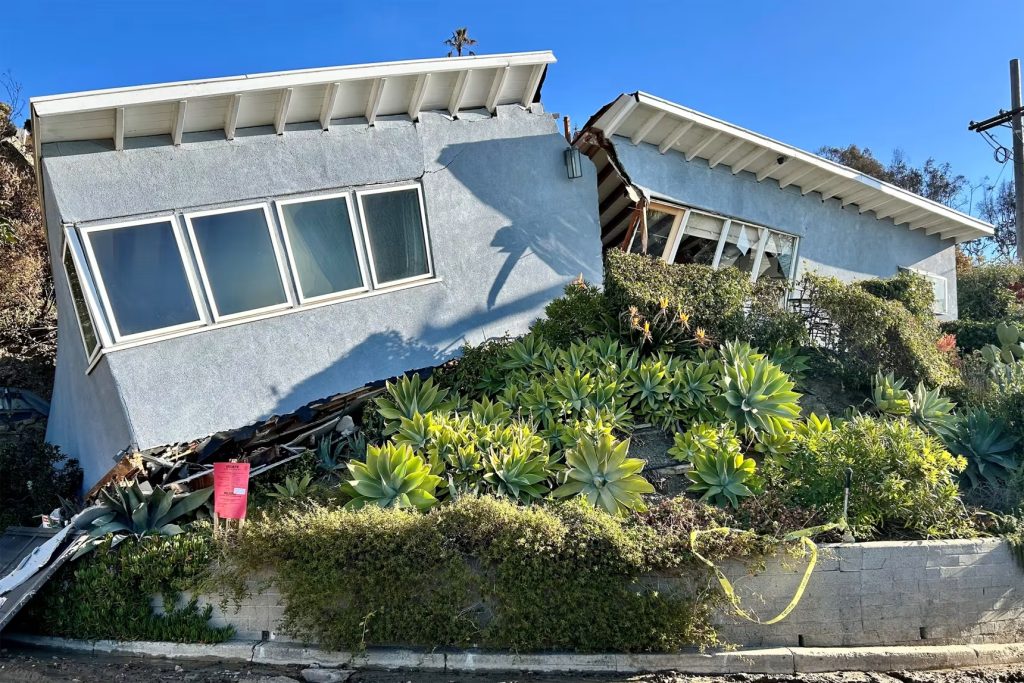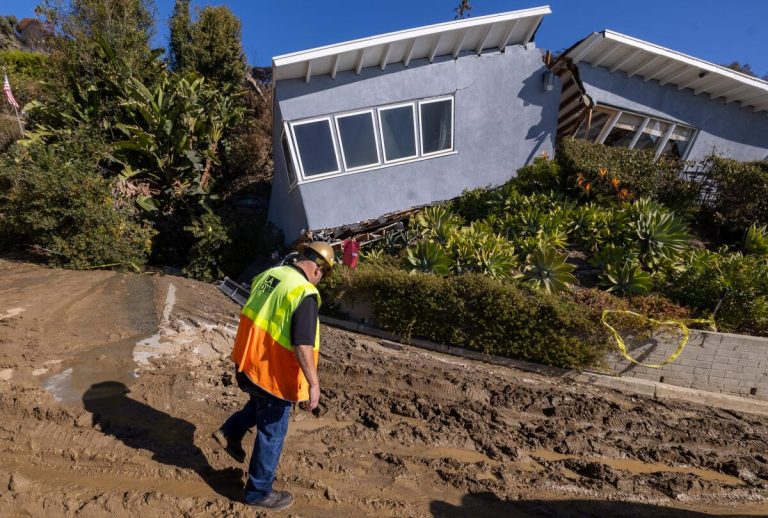The Summary
- A home in Pacific Palisades, which had survived the fire, was split in two by a landslide last week.
- The risk of landslides increases in the months and years following wildfires.
- Wildfires kill the vegetation that helps keep hillsides stable, contributing to ground instability.
- More landslides are expected in the aftermath of the Southern California fires.
Stephen Edwards, a 63-year-old music composer, tragically lost his Pacific Palisades home in the wildfire that has been ravaging the area for the past week and a half.
Edwards had hoped for a backup: a second property nearby that he typically rents out.
While this second house initially seemed to have survived the fire, which has scorched over 23,000 acres and destroyed an estimated 5,000 structures, according to the California Department of Forestry and Fire Protection, disaster struck in a different form. About a week ago, a landslide caused Edwards’ neighbor’s house to crash into his rental, splitting it in two.
Describing the second home, Edwards recalled, “It was a cool place to make music, to be super chill and relaxing. You could look at the water and listen to the waves. It was amazing.”
Now, he’s uncertain whether the damage from this incident will be covered by his insurance or that of his neighbor.

The landslide that impacted Edwards’ property is likely just one of many triggered by the extreme fires sweeping through the Greater Los Angeles area, as wildfires are known to cause ground instability.
“The next major threat is debris flow and landslides,” warned Farshid Vahedifard, chair of the Civil and Environmental Engineering Department at Tufts University.
Vegetation, especially plant roots, plays a crucial role in stabilizing soil, Vahedifard explained. When the vegetation burns away, the soil becomes more prone to movement. Additionally, as ash builds up on the ground, it can prevent water from infiltrating the soil, leading to significant runoff. Over time, this water flow can carve out pathways that make it easier for dirt, debris, and even entire structures to slide downhill.
Vahedifard noted that many areas in Southern California have steep slopes made of loose sediment, making them particularly vulnerable.
“These conditions make the region prone to landslides and debris flows, especially when external triggers, such as wildfires, are present,” he said.
While landslides typically follow wildfires, the process usually unfolds over several years. Edwards’ situation, with a landslide occurring while the Palisades Fire was still active, is relatively unusual.
“You typically need some sort of water trigger,” Vahedifard said.
Southern California has received less than one-tenth of an inch of rain since early May, but in this case, Vahedifard speculated, “the firefighters’ efforts may have acted as the trigger.”

Adam VanGerpen, a Los Angeles Fire Department captain, warned that future landslides in the burn areas from the recent fires will be a significant concern once the rainy season begins.
“The homes located within the burn scars of a fire are the most vulnerable, with the highest risk for mudslides or debris flows,” VanGerpen explained.
California typically receives about 90% of its annual precipitation between October and April. However, Southern California has faced an unusually dry start to what should be its wet season, according to the U.S. Drought Monitor—the driest beginning in 44 years.
When rain finally arrives, VanGerpen said, “We’ll need to be vigilant. We’ll have to remind homeowners to stay alert, and we’ll need geologists to conduct soil samples and studies to ensure stability.”
He added that the department doesn’t anticipate an immediate surge in landslides.
“This area appears to have a significant amount of water running through it,” he said, referencing the location of Edwards’ home.
Vahedifard suggested that the LAFD’s strategy should involve surveying the land to identify the most landslide-prone areas, using vegetation and slope maps as a starting point.
He also emphasized that any rebuilding plans must address the risks of both future wildfires and landslides.
“If we’re building in wildfire-prone areas or on steep slopes, we need to ensure our foundations are strong enough to handle the load,” he said. “We must apply stabilizing measures to keep structures secure against landslides.”
Despite the challenges, Edwards remained positive on Thursday. He is currently staying at an Airbnb in Venice.
“I mean, we’re lucky to be out, you know?” he said. “We’re lucky to be safe, and my wife’s safe, my daughter’s safe, and my dogs are safe. That’s the biggest thing.”

